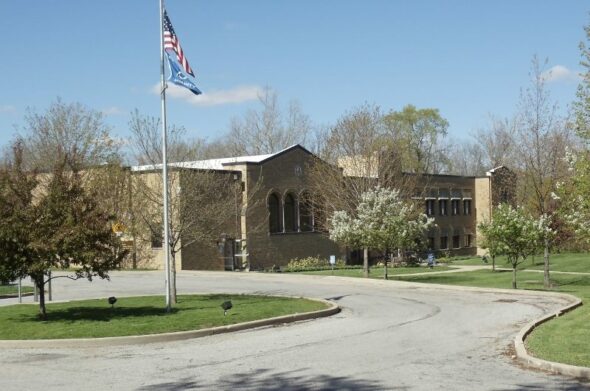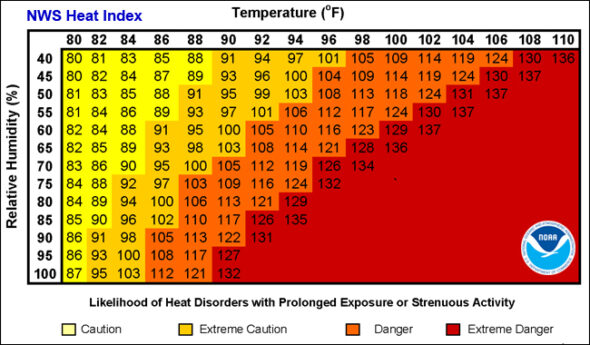
The John Bryan Community Center has been designated a 24-hour cooling center. The Yellow Springs Library is also available during hours of operation. In an emergency, please call 911. (Photo courtesy of Village of Yellow Springs Facebook page)
Emergency cooling shelters in effect for heatwave
- Published: June 17, 2024
The National Weather Service has posted that the first significant heat wave this season will impact much of the Midwest, Great Lakes, Mid-Atlantic and Northeast this week.
Record high temperatures and rapid onset drought is possible, and a heat advisory is in place for the Central United States and Northeast. Because the current high temperatures can be life threatening, advises caution and preparedness:
• Drink plenty of fluids, stay in an air-conditioned room, stay out of the sun, and check up on relatives and neighbors. Young children and pets should never be left unattended in vehicles under any circumstances.
• Take extra precautions if you work or spend time outside. When possible reschedule strenuous activities to early morning or evening. Know the signs and symptoms of heat exhaustion and heat stroke. Wear lightweight and loose fitting clothing when possible.
• Air quality also declines during heatwaves, especially the production of ozone, which can make breathing difficult. It’s advisable to stay indoors and limit strenuous physical activity.
• To reduce risk during outdoor work, the Occupational Safety and Health Administration recommends scheduling frequent rest breaks in shaded or air conditioned environments.
• Anyone overcome by heat should be moved to a cool and shaded location. Heat stroke is an emergency! Call 9 1 1.
The village has designated several emergency cooling shelters, which villagers are advised to seek shelter in if they have no access to a cool environment.
John Bryan Center
The Village of Yellow Springs has designated the John Bryan Community Center, located at 100 Dayton Street, as an emergency cooling center during the current heat wave and until further notice. Though the doors of the center may be locked in the evening, people may use the call button. The center may be accessed through the doors marked “Police Department.” For more information, call the Police Department’s non-emergency number, 937-767-7206.
Yellow Springs Library
All Greene County Community Libraries are official cooling centers as designated by the Red Cross and the Springfield-Greene County Office of Emergency Management. The Yellow Springs Library, located at 415 Xenia Ave., is open Monday through Thursday, 10 a.m.–8 p.m.; Friday, 10 a.m.–6 p.m.; and Saturday, 10 a.m.–5 p.m., and can be reached at 937-352-4003. Each location provides air conditioning, charging stations, drinking fountains, and access to other community resources and assistance.
Yellow Springs Senior Center
The Yellow Springs Senior Center, located at 227 Xenia Ave., 937-767-5751, is also available as a cooling center. The center’s hours are Mon.-Fri., 9:30 a.m.-4 p.m.
Welfare checks
If you are concerned about an individual’s well-being, please contact the Yellow Springs Police Department via the non-emergency number, 937-767-7206, to arrange for a welfare check.
Why heat can be so dangerous
The heat index, also known as the apparent temperature, is what the temperature feels like to the human body when relative humidity is combined with the air temperature. When the body gets too hot, it begins to sweat, and if the sweat is not able to evaporate, the body cannot regulate its temperature. When humidity is high, evaporation slows down. That is why a “dry heat” may seem more bearable than a “humid heat.”
Dehydration
In any heat, it is critical to remain hydrated. Signs of dehydration include:
• Headache, delirium, confusion.
• Tiredness (fatigue).
• Dizziness, weakness, light-headedness.
• Dry mouth and/or a dry cough.
• High heart rate but low blood pressure.
• Loss of appetite but maybe craving sugar.
• Flushed (red) skin. Swollen feet. Muscle cramps.
• Heat intolerance, or chills.
Rehydration can be achieved by drinking water, moderately strong coffee and tea, or skim and low fat milk. Eating fruits and vegetables can also be helpful. In more severe cases, an oral hydration solution is recommended. If symptoms persist, please call 911 or get to a hospital or emergency clinic.
Heat index chart
The chart below shows the perceived temperature with respect to actual temperature and humidity. Note the cautionary zones.

National Weather Service heat index chart.
Sources: Weather.gov, my.clevelandclinic.org, healthline.com
The Yellow Springs News encourages respectful discussion of this article.
You must login to post a comment.
Don't have a login? Register for a free YSNews.com account.











No comments yet for this article.